Physical Address
304 North Cardinal St.
Dorchester Center, MA 02124
Physical Address
304 North Cardinal St.
Dorchester Center, MA 02124
Future of Artificial intelligence (AI) has moved from science fiction to a real part of our lives. It has changed many industries worldwide. The first AI research started in 1956 at Dartmouth Summer Research Project. IBM’s Deep Blue beating chess champion Gary Kasparov showed AI’s power in the real world.
Now, with generative AI and big language models like ChatGPT, AI can do even more. We’re looking forward to big changes in AI’s future. These changes will make life faster, improve work, and raise privacy concerns.
In the next five years, AI will change education, healthcare, finance, law, and transportation. These areas will see big changes with AI.
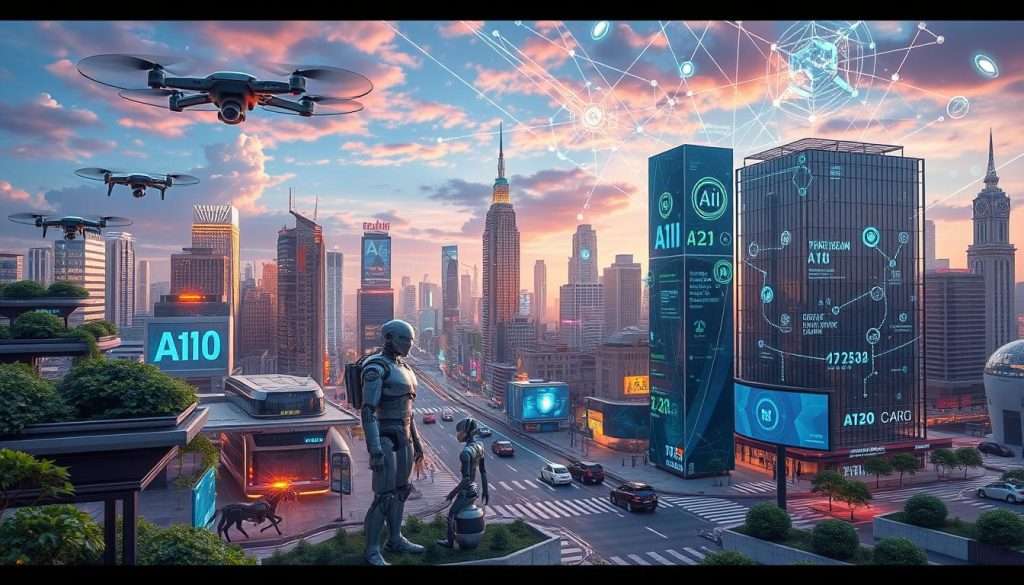
The history of artificial intelligence (AI) is amazing. It started in the 1700s. Thomas Bayes created a key idea in 1763. This idea helped AI grow.
The 1950s were big for AI. Alan Turing wrote about a test for machine smarts. John McCarthy named the field “Future of artificial intelligence.”
In the 1990s, Deep Blue beat a chess world champion. This showed Artificial Intelligence’s power. The 2000s brought robots like ASIMO and Kismet.
The 2010s saw IBM’s Watson win on “Jeopardy!”
AI has seen many important moments. The 1960s had the first industrial robot and ELIZA, a talking program. The 1970s led to digital helpers.
The 1980s brought the first driverless car and Jabberwacky, a chatbot.Future of Artificial Intelligence has grown a lot, from early ideas to now. GPT-3 is a big step forward. Artificial Intelligence’s future looks bright, with big changes coming.
Future of Artificial Intelligence has grown a lot since the 1950s. Now, AI systems can do many things, from simple tasks to trying to think like humans. They use smart learning algorithms to think, learn, solve problems, and make choices.
It’s important to know the difference between AI and machine learning. AI tries to be as smart as humans. Machine learning uses data to get better without being told how. This has led to AI being used in many areas, like making things easier and improving health and education.
| AI System Type | Characteristics |
|---|---|
| Narrow AI | Designed to excel at specific, well-defined tasks, such as playing chess or diagnosing medical conditions. |
| General AI | Aims to achieve human-level intelligence and perform a wide range of cognitive functions, similar to the adaptability of the human mind. |
| Reactive AI | Operates based on immediate sensory inputs, without maintaining an internal model of the world or using past experiences to inform decisions. |
| Limited Memory AI | Can use past experiences to inform current decisions, but has a limited memory capacity compared to general AI. |
| Self-Aware AI | Hypothetical AI systems that would possess self-awareness and consciousness, similar to human sentience. This level of AI is not yet achieved. |
As AI systems get better, they are changing many areas. The mix of machine learning capabilities and Future of artificial intelligence applications is making big changes. These changes could lead to huge improvements in health, finance, and more. But, they also bring up big questions about ethics and rules.
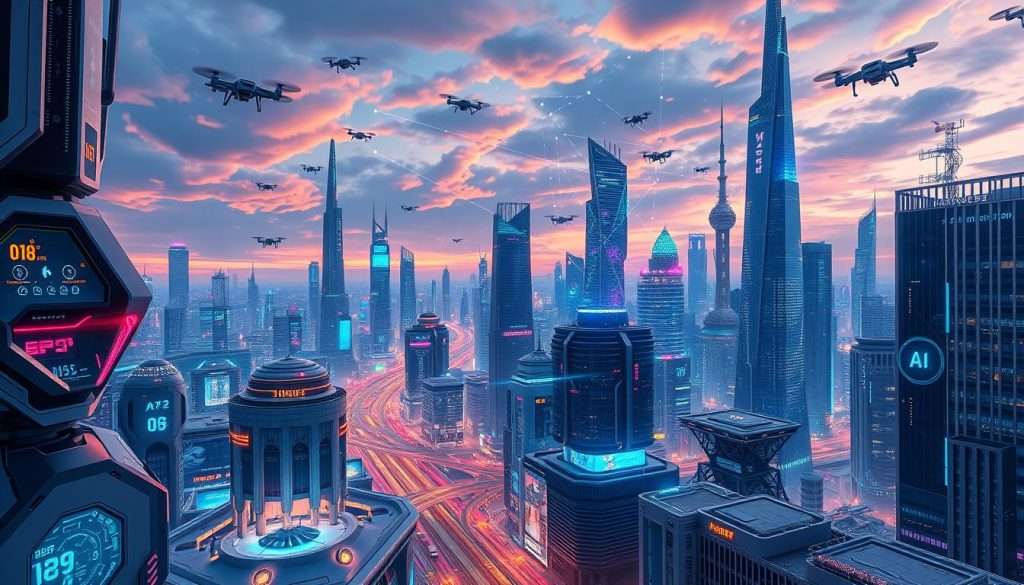
Future of Artificial Intelligence is changing many industries. This includes healthcare, finance, and manufacturing. Future of Artificial Intelligence is making big changes in how these sectors work and what they offer.
In healthcare,Future of Artificial Intelligence is making diagnoses more accurate. It helps create treatment plans that fit each patient. AI also keeps a close eye on patients’ health.
AI can look at medical scans better than humans. This helps find diseases early. Treatment plans can be made just for you, based on your genes.
The finance world is getting a boost from AI. AI helps spot fraud, plan your finances, and talk to customers. These changes make things more efficient and cost-effective.
They also make dealing with money easier for everyone. This is good news for those who use financial services.
AI and robotics are changing manufacturing. They make machines work better and last longer. AI checks products for quality, making them better.
But, AI and robots might take some jobs. They could replace up to 20 million jobs in manufacturing by 2030. This is a big worry for workers.
AI will change many jobs in the future. We might need more people who can think creatively and solve problems. We also need to think about how to use AI right, like avoiding bias and keeping data safe.
| Industry | AI Transformation | Key Impacts |
|---|---|---|
| Healthcare | Enhanced diagnostics, personalized treatment plans, improved patient monitoring | Increased accuracy, tailored therapies, enhanced patient outcomes |
| Finance | Fraud detection, financial planning, automated customer service | Improved efficiency, reduced costs, enhanced customer experience |
| Manufacturing | Predictive analytics, quality inspections, increased automation | Higher productivity, improved product quality, potential job displacement |
Generative AI is changing the game in creative fields. Tools like DALL-E, Stable Diffusion, and Firefly can make images that look real. This shows how AI can create art that’s hard to tell from human-made.
AI is not just for pictures anymore. Text-to-video tech is getting better fast. Runway is leading the way in AI video, helping filmmakers and creators.
Big studios are now using AI in their work. They use it to make actors look younger and improve special effects.
AI is also changing marketing and training. Synthesia lets you make deepfake avatars for personal content. This makes brands more relatable and engaging.
As AI gets better, the creative world will change a lot. Companies that use this tech will lead the way. They’ll be the ones pushing the limits of what’s possible.

The world of artificial intelligence in art is changing fast. Generative AI is making new kinds of art, from images to videos. This is exciting for many industries.
As we move into this new world, using these technologies wisely is key. It will help businesses stay ahead and give their audiences amazing experiences.
Artificial intelligence (AI) is changing the job market a lot. It’s making some jobs disappear but also creating new ones. This is happening in many different areas.
AI might change up to 40% of jobs worldwide. Jobs in admin, law, and making things are at risk. But, new jobs in AI, robotics, and designing for AI are starting to appear.
The job market now wants skills in STEM, coding, and thinking critically. People need to keep learning as AI changes many jobs.
New ways of working with AI are coming. These aim to make AI help humans, not replace them. It’s important to train workers well to handle these changes.
| Sector | Impact of AI | New Job Opportunities |
|---|---|---|
| Finance | Automated fraud detection, enhanced risk analysis | AI ethics specialists, data scientists, machine learning engineers |
| Healthcare | Automated disease diagnosis, personalized treatment plans | AI-powered medical research, virtual nursing assistants |
| Manufacturing | Increased automation, improved quality control | Robotic engineers, AI-driven supply chain optimization |
AI is making big changes in the job market. We need to work together with AI to make sure everyone has a good job in the future.
Artificial intelligence (AI) is becoming more common. This raises big questions about keeping our privacy safe. AI can handle lots of personal data, which is a big worry.
There’s also fear that AI could spread false information, especially in politics. Deepfakes, which are fake videos or photos, are a big problem. They could be used in elections and the media.
AI ethics means making sure AI is used right. It’s about avoiding biases and being open and honest. Privacy in AI is key because AI uses our personal data. We need to make sure this data is safe.
Artificial intelligence risks go beyond just privacy. They include fake news, controlling people, and losing jobs because of automation.
We need to tackle these issues to make AI better. Leaders and policymakers must work together. They need to create rules that help AI but also protect us.
More research and talking about AI’s ethics is needed. This will help us use AI for good. It’s important for AI to help everyone, not just a few.
| Ethical Concerns | Privacy Challenges |
|---|---|
| Bias and discrimination in AI-driven decision-making | Unauthorized access to personal data collected by AI systems |
| Transparency and accountability in AI applications | Lack of control over how personal data is used by AI algorithms |
| The impact of AI on employment and workforce dynamics | Potential for AI-generated content to be used for surveillance and monitoring |
| The use of AI in sensitive domains like healthcare and law enforcement | Risks of AI-powered deepfakes and their misuse in various sectors |
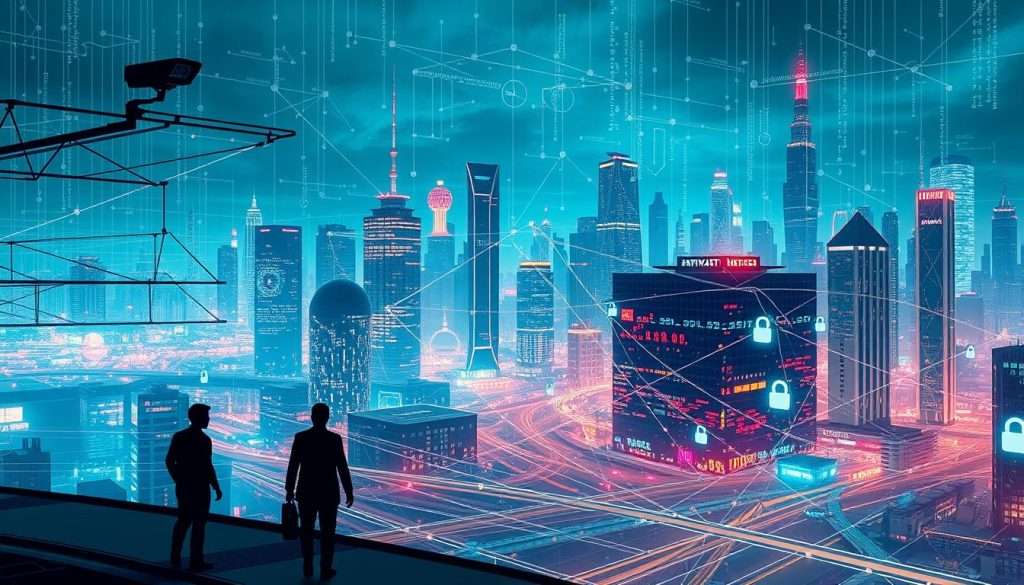
The rules for artificial intelligence (AI) are changing fast. Governments worldwide are working on laws for this new tech. The European Union’s AI Act is a big step, setting a global standard. In the United States, different levels of government are making their own AI laws.
The European Union’s AI Act sorts AI into risk levels. It has strict rules for high-risk systems. In the United States, President Biden wants more AI research and development. He also wants AI to be clear and fair.
The AI Bill of Rights aims to protect people. It wants AI to be open and fair. This bill helps keep AI systems safe and responsible.
Following new AI rules will be hard for companies. Companies making high-risk AI must follow President Biden’s rules. The EU’s AI Act guides AI use in the European Union, including businesses there.
As AI gets better, new legal issues will come up. We need good rules that let AI grow but stay safe. It’s important to work together on AI laws. This includes governments, experts, and lawyers.
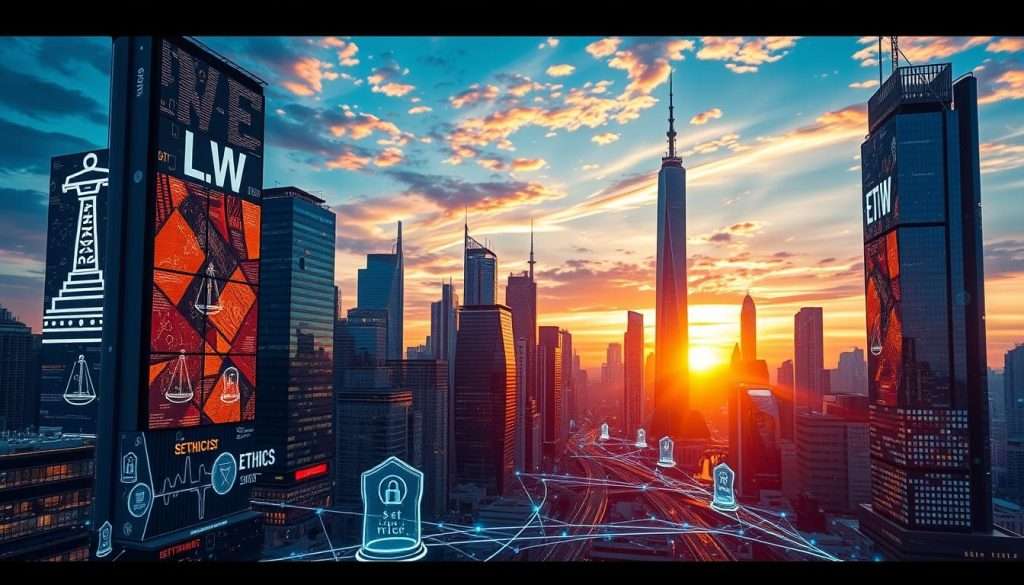
Artificial Intelligence (AI) is changing education. It’s making learning and teaching better. AI helps students learn in new ways and teachers teach more efficiently.
Adaptive learning platforms use AI to make lessons fit each student’s needs. This makes learning more fun and effective. AI also helps with grading and other tasks, so teachers can focus on teaching.
AI does more than just help in the classroom. It looks at student data to help everyone learn equally. AI also makes learning fun with interactive tools.
| AI Application | Impact on Education |
|---|---|
| Adaptive Learning Platforms | Personalize lessons, assessments, and materials to individual student needs |
| Virtual Assistants and Automated Grading | Enhance administrative efficiency, allowing educators to focus on strategic work |
| AI-driven Data Analytics | Provide a broader view of student data, supporting equity and addressing skill gaps |
| Interactive Learning Tools | Engage students in personalized and dynamic ways, making learning more enjoyable and effective |
AI is getting better, and it will change education even more. It will help students and teachers succeed in an AI-driven world.
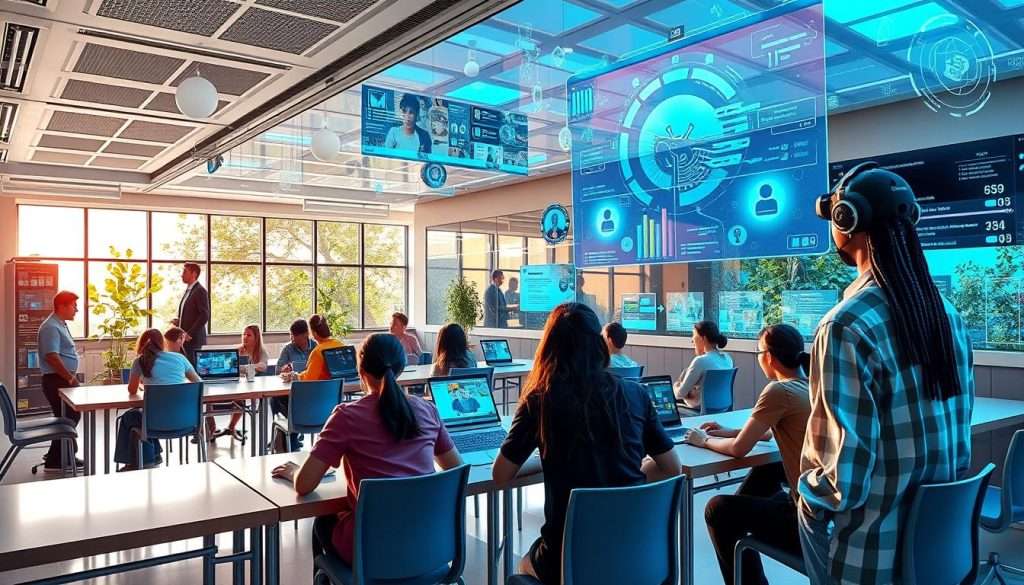
The world of artificial intelligence (AI) is always changing. Researchers are exploring new things every day. They’re working on making AI better and more friendly to our planet.
Multimodal AI is a big area of focus now. It lets machines understand text, images, and sounds all at once. This could change how we talk to machines, making it feel more natural.
Robotics is also getting a boost from AI. Now, robots can do many different tasks. They’re becoming more useful in our daily lives.
AI researchers are also working on making AI use less energy. This is important for making AI more available and useful. It could help AI become a big part of our lives.
Looking to the future, AI research is going even further. They want AI to be smarter and learn from less data. This could make AI even more helpful in many areas.
As AI research keeps moving forward, we’ll see new and exciting things. From better AI that understands us to robots that can do more, the future is looking bright.
| AI Research Area | Key Advancements | Potential Impact |
|---|---|---|
| Multimodal AI | Ability to process text, images, and audio simultaneously | Enabling more natural and intuitive human-machine interaction |
| Robotics | Development of versatile, general-purpose robots | Expanding the capabilities of robots in various industries |
| Energy-efficient AI | Designing more sustainable and environmentally friendly AI systems | Increasing the accessibility and scalability of AI applications |
| Reasoning and Adaptability | Improving AI’s ability to reason, learn from smaller datasets, and adapt to diverse environments | Enabling more versatile and accessible AI solutions across industries |
The future of artificial intelligence is very promising. It could change many industries and make our lives better. AI will help in healthcare, finance, and more, making things more efficient.
Generative AI is already exciting people. It shows how AI will change our lives in big ways.
But, there are challenges ahead. We need to think about jobs, privacy, and ethics. It’s important for everyone to work together to make AI good for all.
We should teach AI in schools and talk about its impact. This will help us use AI wisely.
AI will soon be a big part of our lives. With more research and focus on people, AI can help us a lot. It’s up to us to make AI better for everyone.
AI started in the 1930s. It grew to big wins like IBM’s Deep Blue beating Gary Kasparov in chess in the 1990s. Now, with generative AI and ChatGPT, AI’s skills are even more impressive.
Today’s AI includes Narrow AI, General AI, and more. These systems can think, learn, solve problems, and make decisions.
AI is changing healthcare, finance, and manufacturing. It helps with diagnosis, treatment plans, and automates tasks. This leads to better productivity and new business ideas.
Generative AI is changing how we create. It makes realistic images, videos, and deepfake avatars. This is big for film and marketing.
AI will change 40% of jobs worldwide. It will replace some jobs but also create new ones. New fields like AI engineering and UX design for AI are emerging. Humans and AI will work together more.
AI’s ability to handle lots of personal data raises privacy worries. There’s also fear of AI-generated misinformation and deepfakes being misused.
AI laws are changing fast. The European Union has the AI Act, and the U.S. is making its own laws. Companies must follow these rules, and legal issues will keep coming up.
AI is making learning personal and efficient. It helps teachers by doing routine tasks. AI could make learning fun and effective, changing schools forever.
New AI techs are pushing limits in areas like multimodal AI and robotics. Future goals include better reasoning, energy use, and learning from less data.
more article: https://msmgadgets.com/blog/